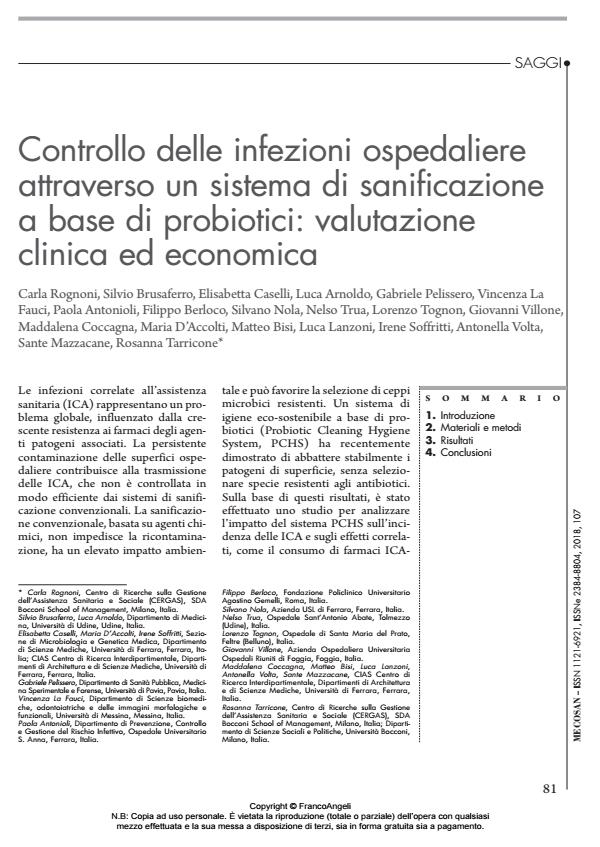Controllo delle infezioni ospedaliere attraverso un sistema di sanificazione a base di probiotici: valutazione clinica ed economica
Journal title MECOSAN
Author/s Carla Rognoni, Silvio Brusaferro, Elisabetta Caselli, Luca Arnoldo, Gabriele Pelissero, Vincenza La Fauci, Paola Antonioli, Filippo Berloco, Silvano Nola, Nelso Trua, Lorenzo Tognon, Giovanni Villone, Maddalena Coccagna, Maria D’Accolti, Matteo Bisi, Luca Lanzoni, Irene Soffritti, Antonella Volta, Sante Mazzacane, Rosanna Tarricone
Publishing Year 2019 Issue 2018/107
Language Italian Pages 18 P. 81-98 File size 407 KB
DOI 10.3280/MESA2018-107005
DOI is like a bar code for intellectual property: to have more infomation
click here
Below, you can see the article first page
If you want to buy this article in PDF format, you can do it, following the instructions to buy download credits

FrancoAngeli is member of Publishers International Linking Association, Inc (PILA), a not-for-profit association which run the CrossRef service enabling links to and from online scholarly content.
Healthcare Associated Infections (HAI) are a global concern, influenced by the increasing drug resistance of HAI-associated pathogens. The persistent contamination of hospital surfaces contributes to HAI transmission, which is not efficiently controlled by conventional cleaning. Conventional cleaning with chemical agents does not prevent recontamination, has a high environmental impact and can favor selection of drug-resistant microbial strains. An eco-sustainable probiotic-based cleaning system (Probiotic Cleaning Hygiene System, PCHS) recently showed to stably abate surface pathogens, without selecting antibiotic-resistant species. Based on those results, a multicentre, pre-post-interventional study was performed for 18 months in the Internal Medicine wards of five Italian public hospitals, aimed to analyze the impact of PCHS on HAI incidence and related effects, such as HAI-associated antimicrobial drug consumption and costs. Surface bioburden was also analyzed. Globally, 11842 patients and 24875 environmental samples were surveyed. PCHS was associated with a significant decrease of HAI cumulative incidence from a global 4.8% to 2.3% (OR = 0.44, 95% IC 0.35 ± 0.54) (p < 0.0001). Concurrently, PCHS was associated with a stable decrease of surface pathogens, compared to conventional sanitation (mean decrease 83%, range 70 ± 96.3%). Drug consumption associated with HAI onset showed a global 60.3% decrease, with a 75.4% decrease of the associated costs. Our study provides findings which support the impact of a sanitation procedure on HAI incidence, showing that the use of a probiotic-based environmental intervention can be associated with a significant decrease of the risk to contract a HAI during hospitalization and related costs. Once confirmed in larger experiences and other target populations, this eco-sustainable approach might be considered as a part of infection control and prevention strategies.
Keywords: Healthcare associated infections, antimicrobial resistance, antibiotic consumption, antibiotic costs
Carla Rognoni, Silvio Brusaferro, Elisabetta Caselli, Luca Arnoldo, Gabriele Pelissero, Vincenza La Fauci, Paola Antonioli, Filippo Berloco, Silvano Nola, Nelso Trua, Lorenzo Tognon, Giovanni Villone, Maddalena Coccagna, Maria D’Accolti, Matteo Bisi, Luca Lanzoni, Irene Soffritti, Antonella Volta, Sante Mazzacane, Rosanna Tarricone, Controllo delle infezioni ospedaliere attraverso un sistema di sanificazione a base di probiotici: valutazione clinica ed economica in "MECOSAN" 107/2018, pp 81-98, DOI: 10.3280/MESA2018-107005